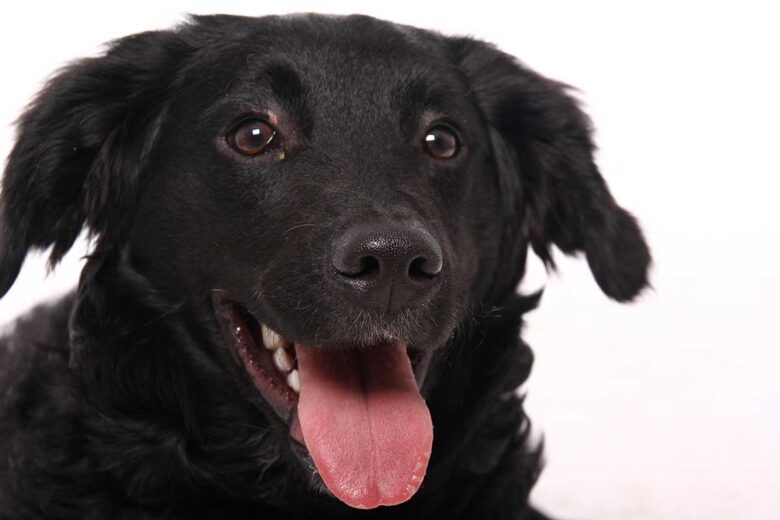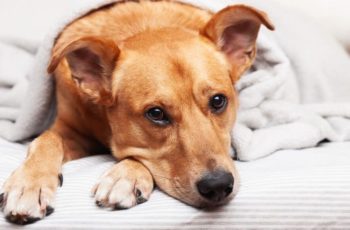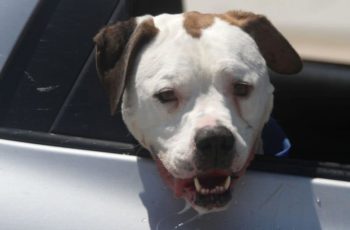This post may contain affiliate links. We may earn money or products from the companies mentioned in this post.
A Lab Chow mix, also commonly called a Chabrador, is a designer mixed breed dog you get when mixing a loveable and intelligent Labrador Retriever with a furry and vigilant Chow Chow.
In the best-case scenario, the resulting medium-sized dog is a friendly companion with a decent guarding instinct.
But, as is the case with all mixed breeds, what you expect and what you get is not always the same thing!

Your Lab Chow mix could be goofy and friendly, or they could be hyper-vigilant and tend to chase smaller animals.
Either way, with the right training, you will have a dog that makes a wonderful addition to your family if you can provide the right structure.
Read on for everything you need to know about the Lab Chow mix to help you decide whether they are the right dog breed for you.
Vital Statistics
- Breed: mix between a Labrador Retriever and a Chow Chow
- Height: 18-22 inches
- Weight: 45-80 pounds
- Lifespan: 9-12 years
- Coat: high-shedding, double-layered, waterproof, short to medium length
- Colors: light tan, black, gold, cream, blue, reddish-brown
- Exercise: around 60 minutes per day
History Of The Breed
Chow Chows are one of the oldest known dog breeds that were bred in China from at least 2,000 years ago.
They are known to have been beloved by the Chinese emperors. They were used as guard dogs for temples and scent dogs for imperial hunts.
Sigmund Freud had a Chow Chow named Jo-Fi Ling that he used in therapy sessions to help judge patients’ mental state.
Martha Stewart, Elvis Presley, Janet Jackson, and Walt Disney are also famous Chow Chow owners.
Labrador Retrievers were bred in England in the 19th century from dogs imported from Canada that were favored by fishermen as companions and retrievers.
They were bred to retrieve downed prey on both land and water.
Labrador Retrievers became very popular in the 10th century thanks to their friendly demeanor and high degree of intelligence.
They are now often seen as working dogs, especially in roles such as disability support.
Breeders started to experiment with mixing the two breeds in the 1990s.
The aim was to create a breed with the intelligence and friendly demeanor of a Lab but with some additional guard dog instincts and the adorable fluffy coat associated with the Chow.
Lab Chow Mix Appearance
Both Labrador Retrievers and Chow Chows are medium-sized dogs with a sturdy build, so you can expect the same from their mixed-breed offspring.
Labradors tend to be between 20.5 and 22.5 inches tall and weigh 45 to 80 pounds.
Chow Chows are very similar, measuring 17-22 inches in height and weighing 35-90 pounds. Their offspring are similar, measuring 18-24 inches and 45-90 pounds.
Labs are famous for their high-shedding double coats, while Chow Chows are famous for their dense double coats that almost look like the fur of a bear.
Their hair is also thicker around the face, giving them a lion’s mane appearance.
Lab Chow mixes tend to have the thick, furry coat of a Chow Chow but are a bit shorter, thanks to their Lab parentage.
Whatever their coat, be prepared because it will shed a lot throughout the year. They should have a good brushing at least twice a week.
Chow Labs are usually a solid color, commonly light tan, black, gold, cream, blue, or reddish-brown. Mixed coloring is known but uncommon.
Both Labradors and Chow Chows have a thick neck and a fairly large and long muzzle that ends at a flat point, so these are characteristics of their mixed-breed puppies.
While Chows have short, pointed ears, Labs have long, hanging years, and these are more common to see among their pups.
Meanwhile, Chow Chows have a distinctive purple and black tongue, which is unique to them and the shar pei, another dog of Chinese origin.
This is another common characteristic among their mixed-breed offspring. Consider yourself lucky if your dog inherits the curly tail of a Chow Chow.
Chabrador Temperament
While Labrador Retrievers and Chow Chows are fairly compatible physically, they have very different personalities, and it can be unpredictable how they will mix.
Labrador Retrievers are known to be incredibly friendly dogs that bond with their families quickly and tend to make friends rather than growl at strangers.
They are also very intelligent and eager to please. They can be trained to complete very complex tasks, so they are often seen as disability support dogs.
On the downside, labs love being around people and can’t tolerate being left alone for extended periods of time.
Chow Chows, on the other hand, are territorial and independent.
This makes them great guard dogs as they are alert to new people and animals, and they are independent enough to act on their own without requiring human direction.
Because they are independent, they don’t necessarily bond as quickly with their family but can tolerate being on their own.
Chow Chows also have a natural hunting instinct and can have a tendency to chase smaller animals. This tendency can extend to young children if the dog isn’t properly trained.
They also tend to bond closely with one or two family members, which can make it challenging for other members of the household to look after them.
While Chow Chows look cuddly, they can be quite aloof. They don’t enjoy touching and physical affection in the same way as Labradors.
They can tend toward aggression if they aren’t properly trained and socialized.
So, what do you get when you mix these two opposing personalities?
Ideally, you get a friendly family dog that is intelligent enough to identify strangers in their home space and raise the alarm.
In a perfect world, they are loving and affectionate but can tolerate being alone when everyone is at work.
If you are lucky, you may get a dog that is exactly like this. But you could also get a Labrador-dominant dog that is friendly but needy.
Or you could get a Chow-Chow-dominant dog that is overly territorial and tends to snap at anything they don’t like. They might also be aloof and not as cuddly as you would like them to be.
While you can’t change their natural instincts and personality, a dog’s good training can go a long way.
Ensure your Lab Chow mix is socialized from a young age so they know how to deal with children, smaller animals, and strangers when they are clearly welcomed by the household.
Chow Chows can be resistant to training, so you might also see this trait in your Chow Lab mix. When this is the case, you can benefit from professional training with your pup.
When should you start training a puppy? What age can you begin?
Energy And Exercise
Labradors are high-energy dogs that need a lot of exercise to stay healthy and mentally stimulated. They usually need about an hour a day.
Chow Chows are also energetic, but their thick coat means they can have trouble with overheating in more humid climates.
Bring the two together and the Lab Chow mix does need a lot of exercise, which usually means about an hour a day.
However, it can be useful to split this into two sessions to ensure they don’t get overheated. Both breeds actually love swimming, so this can be a great alternate form of exercise for a Chow Lab mix.
These are fairly large dogs, so they tend to be respectful of space and aware of their own size.
This means they do fine when inside the home—and they should be. These dogs want to be close to their people and won’t be happy if they are always looking in from the outside.
Nevertheless, you should ensure that your Chow Lab mix has an outdoor place to call their own and burn off energy.
They will also love running in a leash-free dog park if they are properly socialized and know how to behave around other dogs.
Health
Chabradors are generally considered to be healthy dogs and may have fewer health problems than both of their parent breeds. They have a healthy lifespan for dogs of their size of between nine and 12 years.
However, they can inherit various health risks that owners should look out for to identify and treat early.
Watch for elbow and hip dysplasia, which is when the joints form incorrectly, leading to mobility issues later in life.
One way to reduce the likelihood of this occurring is to ensure your playful and energetic dog doesn’t get too much exercise as a puppy.
Generally, growing dogs should be limited to five minutes of exercise per day per month of their life. So, a four-month-old puppy only needs about 20 minutes of exercise each day.
Issues with the eyes are also fairly common, including entropion, glaucoma, and cataracts.
While most of these conditions develop later in life, entropion is when the eyelashes grow inwards. It is a painful condition that can occur in puppies.
Chow Lab mixes may also be at high risk for skin disease, skin cancer, and gastric cancer. Also, watch out for obesity.
They may inherit the absence of the “full” gene from their Lab parent and, therefore, always be on the prowl for food.
Read our guide to the best puppy foods for Labradors and Lab mixes.
Lab Chow FAQs
Are Chow Lab mixes good dogs?
Yes, Chow Lab mixes are good dogs, but their temperament can be unpredictable.
You might get the friendly, family-oriented personality of a Lab or the more reserved and independent personality of a Chow Chow guard dog—or something in between.
Your dog will have their own unique personality, but it’s sure to be a fun one.
Are Chow Chow dogs cuddly?
While Chow Chows look like cuddly teddy bears, they aren’t actually that into hugs and snuggles. They tend to be more reserved and aloof and might not tolerate too much physical affection.
Should You Adopt A Chow Lab Mix?
Now that you know a bit about the Chow Lab mix, are you considering bringing one home? Ask yourself the following questions to help make a final decision:
- Do you have the space, both inside and outside of your home, for a relatively large and energetic dog?
- Do you have other pets or small children that may struggle to bond with a territorial dog?
- Do you have experience training and commanding dogs that might be necessary to deal with an independent and headstrong Chow Lab mix?
- Do you have time to give your dog at least 60 minutes of exercise a day, and will you be able to take them swimming fairly regularly? Are there people around your home most of the time, or will your dog need to spend long periods alone?
- Do you have the patience to brush your dog out at least twice weekly? Is there anyone in your household with dog hair allergies or asthma that might be affected by the high-shedding coat? And can you deal with constantly cleaning up dog hair?
- Are you prepared to make at least a 10-year commitment to care for an adoring companion, and are you willing to love them even if they have a temperament that you didn’t expect?
Once you answer these questions, you should know whether a Chow Lab mix is the right dog breed for you.
You might also be interested in a blue heeler lab mix or a husky Lab mix.
Top Picks For Our Dogs
- BEST PUPPY TOY
We Like: Calmeroos Puppy Toy w/ Heartbeat and Heat Packs – Perfect for new puppies. Helps ease anxiety in their new home. - BEST DOG CHEW
We Like: Bones & Chews Bully Sticks – All of our puppies love to bite, nip, and chew. We love using Bully Sticks to help divert these unwanted behaviors. - BEST DOG TREATS
We Like: Crazy Dog Train Me Treats – One of our favorite treats for training our service dog puppies. - BEST FRESH DOG FOOD
We Like: The Farmer’s Dog – A couple months ago we started feeding Raven fresh dog food and she loves it! Get 50% off your first order of The Farmer’s Dog.
For a list of all the supplies we get for our new service dog puppies check out our New Puppy Checklist on the PuppyInTraining.com blog.
Lab Chow Mix: What To Expect From These Friendly Dogs was last modified: September 18th, 2023 by


